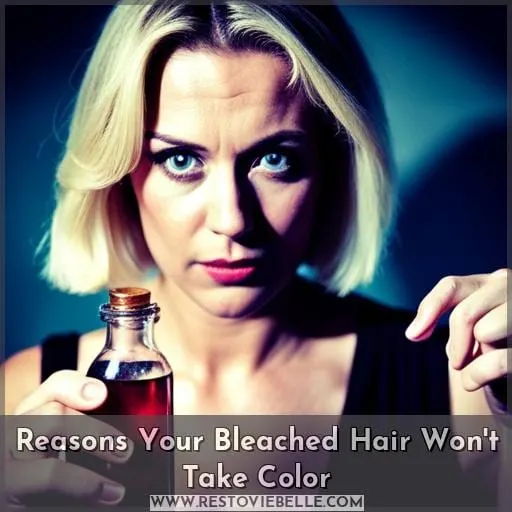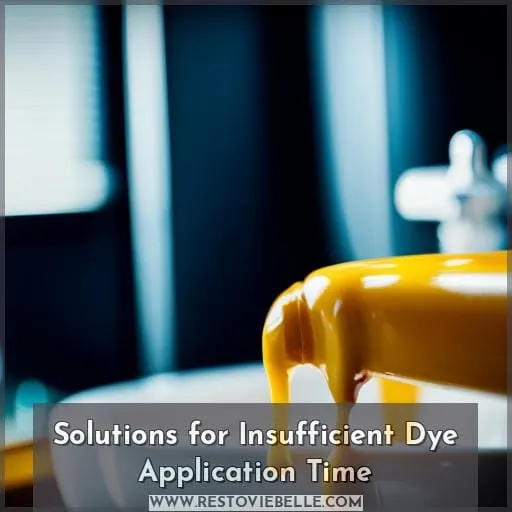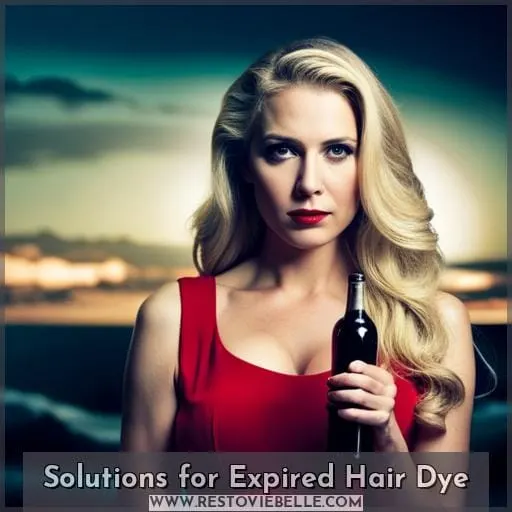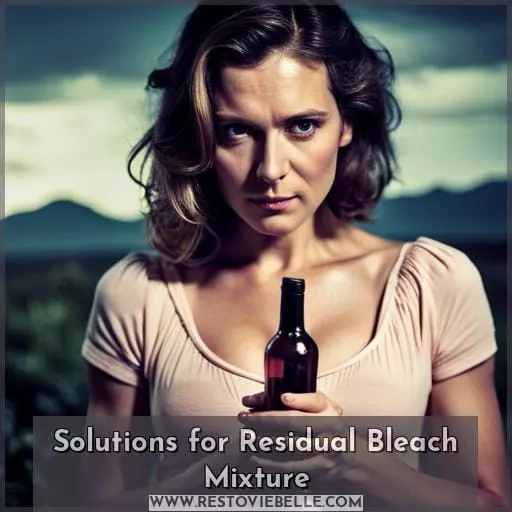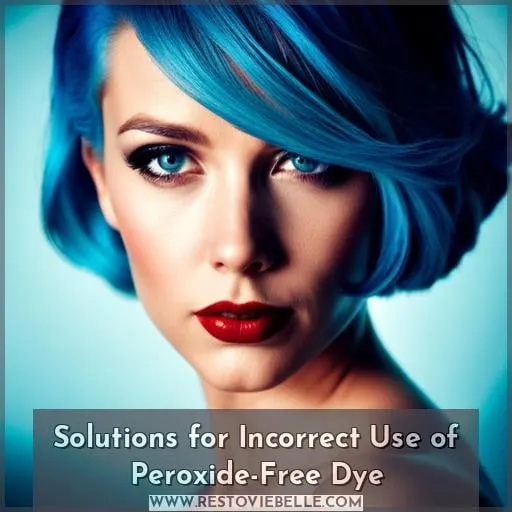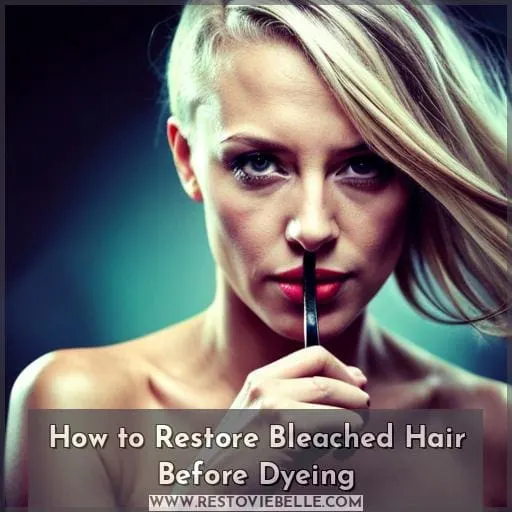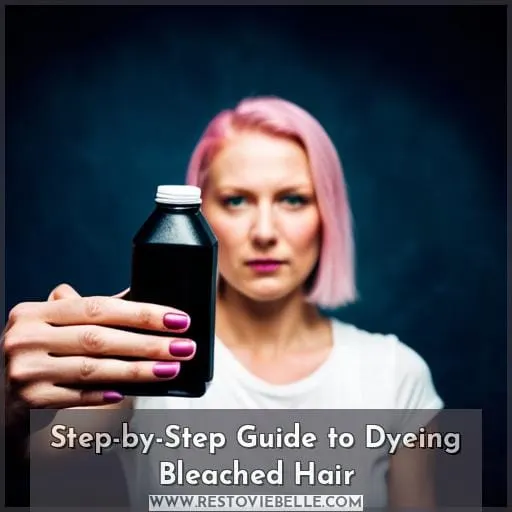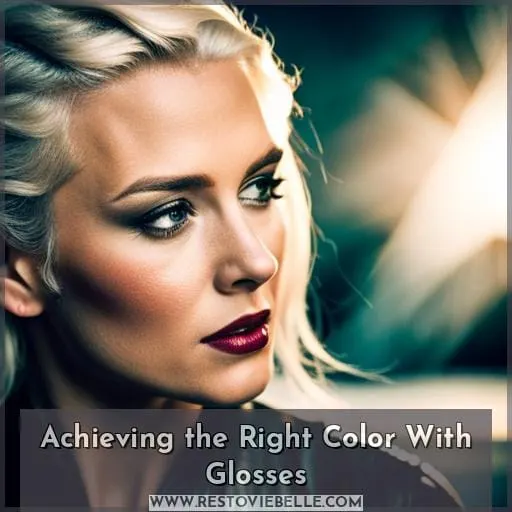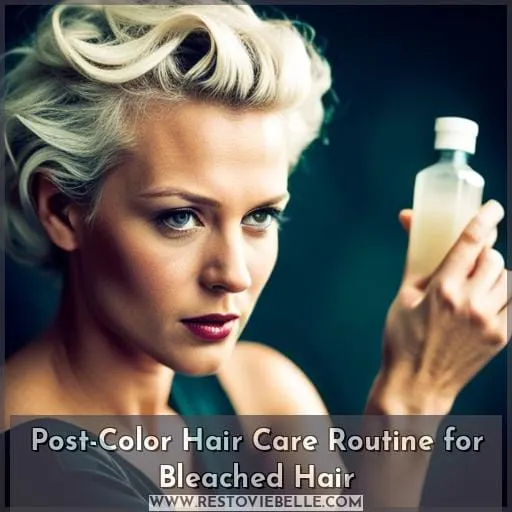This site is supported by our readers. We may earn a commission, at no cost to you, if you purchase through links.
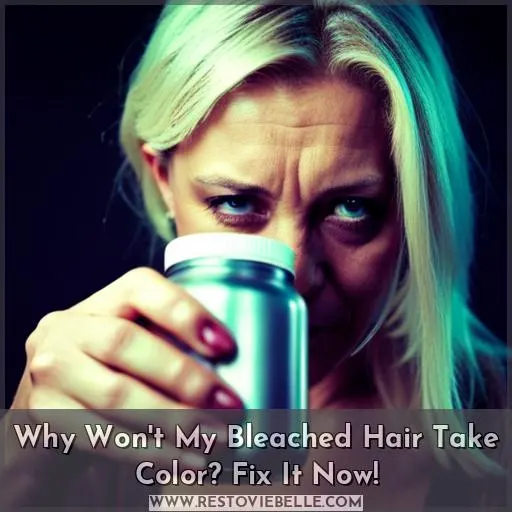 Imagine staring into the mirror, eager to see your newly dyed hair, only to be met with disappointment. Your bleached locks refuse to take on any color. Frustration sets in as you wonder why this is happening and how you can fix it.
Imagine staring into the mirror, eager to see your newly dyed hair, only to be met with disappointment. Your bleached locks refuse to take on any color. Frustration sets in as you wonder why this is happening and how you can fix it.
Don’t worry! In this article, we will explore the reasons behind why your bleached hair won’t take color and provide solutions for achieving vibrant, long-lasting results.
Table Of Contents
- Key Takeaways
- Reasons Your Bleached Hair Won’t Take Color
- Solutions for Insufficient Dye Application Time
- Solutions for Expired Hair Dye
- Solutions for Residual Bleach Mixture
- Solutions for Incorrect Use of Peroxide-Free Dye
- How to Restore Bleached Hair Before Dyeing
- Step-by-Step Guide to Dyeing Bleached Hair
- Achieving the Right Color With Glosses
- Post-Color Hair Care Routine for Bleached Hair
- Frequently Asked Questions (FAQs)
- How long should I wait before re-dyeing my bleached hair?
- Can I use semi-permanent dye on my bleached hair?
- What should I do if my hair dye expires before I use it?
- How can I prevent my hair from becoming damaged during the color correction process?
- Are there any specific products I should avoid using on my bleached hair before dyeing it?
- Conclusion
Key Takeaways
- Insufficient dye application time, expired hair dye, residual bleach mixture, and damaged hair cuticles are common causes of bleached hair not taking color.
- To solve insufficient dye application time, it is important to follow the manufacturer’s instructions, section the hair, use a timer, and avoid distractions.
- To address expired hair dye, reapply fresh dye, check expiration dates, remove residual products, and consider using a peroxide-free dye specifically designed for bleached hair.
- To deal with a residual bleach mixture, thoroughly rinse out the bleach, reapply dye, use a pH-balanced shampoo, and avoid using products that leave residue.
Reasons Your Bleached Hair Won’t Take Color
If you’re wondering why your bleached hair won’t take color, there could be a few reasons.
- Insufficient dye application time – if you didn’t leave the dye on long enough, it may not have had enough time to penetrate the hair fiber.
- Expired hair dye – using outdated products can lead to ineffective results.
- Residual bleach mixture or incorrect use of peroxide-free dyes – are also factors that can hinder color absorption in bleached hair.
Insufficient Dye Application Time
If you find that your bleached hair isn’t taking color as expected, one possible reason could be that you didn’t leave the dye on for a sufficient amount of time.
- Reapply the dye and follow the manufacturer’s recommended processing time.
- Ensure that there are no expired ingredients in your hair dye.
- Remove any residual products or bleach mixture before applying new color.
- Use a peroxide-free dye specifically designed for bleached hair to achieve desired results.
Expired Hair Dye
Expired hair dye can be one of the reasons why your bleached hair won’t take color.
When using outdated dye, check the expiration date on the box before purchasing it. Hair dyes have a shelf life of 3 to 5 years when stored properly, but exposure to heat or sunlight can degrade their components.
To fix this issue, reapply fresh and unexpired hair dye in order to achieve optimal color restoration during your transition process.
Residual Bleach Mixture
When you don’t thoroughly rinse out the bleach from your hair, residual bleach can inhibit the effectiveness of hair dye.
To understand why your bleached hair won’t take color due to a residual bleach mixture, consider these factors:
- Incomplete rinsing of bleach prevents proper dye penetration.
- Residual bleach forms a barrier that hinders dye adherence.
- Hair chemistry and porosity play a role in uneven bleached hair and color issues.
Incorrect Use of Peroxide-Free Dye
When using peroxide-free dye on bleached hair, it’s important to ensure that the correct ingredients are present for the color to take effectively. Incorrect use of peroxide-free hair dye can lead to unsatisfactory results and faded colors.
Make sure you choose a permanent dye with the necessary components for color development. Alternatively, consider semi-permanent dyes that don’t require peroxide but still provide vibrant shades.
It’s crucial to understand your hair texture and consult with professionals about glossing options and post-color care.
Solutions for Insufficient Dye Application Time
If you didn’t leave the dye on your bleached hair for the recommended amount of time, try reapplying it following the manufacturer’s instructions.
Here are some solutions to help ensure sufficient dye application time:
- Follow manufacturer’s instructions: Make sure to read and follow the recommended processing time provided by the hair dye brand.
- Section your hair: Divide your hair into manageable sections before applying the dye. This will help ensure even distribution and better color absorption.
- Use a timer: Set a timer to accurately track how long you have left the dye in your hair. This will prevent under-processing or over-processing.
- Avoid distractions: During application, minimize distractions that may cause you to remove or rinse off the color prematurely.
By taking these steps, you can improve color absorption and achieve more vibrant results when coloring your bleached hair.
Solutions for Expired Hair Dye
Now that you know the solutions for insufficient dye application time, let’s move on to another possible issue: expired hair dye.
Hair dyes have expiration dates, typically ranging from 3 to 5 years when stored properly. Exposure to heat or sunlight can degrade the components of the dye and affect its effectiveness. To avoid this problem, always check the expiration date on your hair dye box before purchasing it.
If you suspect that using outdated hair dye is causing your bleached hair color issues, there’s a simple solution – reapply fresh dye and make sure to check expiration dates in the future. By using a new batch of unexpired hair color products, you can ensure better results in achieving vibrant and long-lasting color on your bleached locks.
Solutions for Residual Bleach Mixture
To address the issue of residual bleach mixture, thoroughly rinsing your hair after bleaching is crucial.
Residual bleach can hinder the effectiveness of hair dye and prevent it from adhering properly to your hair fiber.
In order to fix this problem, you need to reapply the dye and ensure that you rinse out any remaining traces of bleach completely in future applications.
By doing so, you’ll prevent color fading and achieve even coverage with your permanent hair color.
It’s important to follow the instructions provided by the manufacturer for dye reapplication and use a pH-balanced shampoo specifically designed for post-bleach rinses.
Taking these steps will help you avoid breakage, maintain glossiness, and ensure that your newly applied color takes hold effectively on your bleached strands.
Solutions for Incorrect Use of Peroxide-Free Dye
To fix the issue of incorrect use of peroxide-free dye, try reapplying the dye with the proper ingredients and following the manufacturer’s instructions.
When using peroxide-free dyes, it’s important to understand that they may not provide optimal color results on bleached hair due to their lack of ammonia or other strong developer agents. These dyes are designed for a more subtle color change or toning effect rather than dramatic transformations.
If you have already used a peroxide-free dye and your bleached hair hasn’t taken color as expected, consider switching to a professional-grade permanent hair dye that contains ammonia and appropriate developer levels for better penetration into your porous strands.
It’s also recommended to consult with a hairstylist who can assess your specific situation and suggest suitable coloring techniques based on your hair porosity level.
Additionally, maintaining regular salon visits for touch-ups or seeking professional help in achieving desired results may be beneficial in ensuring long-lasting vibrant colors while safeguarding overall hair health.
How to Restore Bleached Hair Before Dyeing
To restore your bleached hair before dyeing, start by using:
- A protein-rich and hydrating conditioner to moisturize your hair. This will help strengthen the cuticles and improve color absorption.
- Additionally, consider using equalizing solutions like Aveda’s BB Damage Remedy to further enhance the condition of your hair and ensure better results.
- Lastly, when choosing a shade of brown for dyeing, take into account your natural tones and texture as they can influence how well the color holds on bleached hair.
Use Protein-Rich, Hydrating Conditioner
To restore your bleached hair before dyeing, start by using a protein-rich and hydrating conditioner.
Protein conditioning helps to strengthen the hair shaft, improving its ability to absorb color.
Look for products that contain ingredients like keratin or hydrolyzed wheat protein for optimal results.
These conditioners will help repair any damage caused by bleaching while providing essential moisture to keep your hair hydrated and ready for color application.
Make sure to thoroughly coat your strands with the conditioner and leave it on for the recommended amount of time before rinsing out.
Consider Equalizing Solutions
Consider incorporating equalizing solutions into your hair care routine as a way to restore bleached hair before dyeing it. These solutions can help balance the porosity of your hair, ensuring better color absorption and more even results.
They can also help remove any residual products or build-up that may be hindering the dye from taking hold.
By using equalizing solutions, you can achieve vibrant and long-lasting color while maintaining the health and shine of your bleached hair.
Choose the Right Shade of Brown Based on Hair Texture
Now, let’s talk about choosing the right shade of brown based on your hair texture to restore your bleached hair before dyeing.
When transitioning from blonde to brown, it’s important to consider your hair texture and its ability to hold color. Curly or dry hair may require extra care and moisture retention. Choose a shade that complements your natural tones and is suitable for easy color maintenance.
Consider consulting with a professional stylist for advice on the best coloring options for you.
Step-by-Step Guide to Dyeing Bleached Hair
Now that you’ve identified the possible causes for your bleached hair not taking color, it’s time to dive into a step-by-step guide to dyeing your hair.
Whether you’re opting for an initial salon appointment or considering an at-home hair color kit, there are important factors to consider.
From filling platinum blonde hair with pigment before adding brunette color to estimating costs and planning follow-up visits with a professional stylist, this guide will ensure successful results in achieving the desired shade on your bleached locks.
Initial Color Appointments and Filling for Platinum Blonde
When transitioning from platinum blonde to a darker shade, you’ll typically have an initial color appointment that can take anywhere from 2 to 5 hours.
During this salon appointment, your stylist may need to fill your hair with pigment before adding the brunette color.
The cost for going from blonde to brown can start at $200 and increase if additional glosses and toners are added.
Alternatively, you can consider using at-home hair coloring kits for convenience and cost savings.
Costs and Consultation for Salon Visits
During your consultation at the salon, the stylist will discuss the average cost and provide recommendations for dyeing your bleached hair.
The cost for dyeing bleached hair can range around $200, depending on additional services such as glosses or toners.
The duration of the process usually takes about 3 hours to ensure proper color application and development.
They may suggest using a 10 or 20 volume developer to achieve lighter hues without further damaging your hair.
At-Home Hair Color Kits as an Option
If you’re looking for an alternative to salon visits, at-home hair color kits can be a convenient option for dyeing your bleached hair.
These kits offer ease of use and come with detailed instructions to guide you through the process.
While they may not always provide the same level of color accuracy as professional salon treatments, many users have reported satisfactory results.
It’s important to read customer reviews and choose a kit that suits your needs and preferences in terms of cost, ease of use, and desired outcome.
Achieving the Right Color With Glosses
To achieve the right color after bleaching, glosses play a crucial role in blending the transition and creating a seamless look.
Glosses can be either sheer or opaque, depending on the effect you desire for your hair. They help balance the color between your natural roots and newly dyed ends, resulting in a more cohesive overall appearance.
Look for at-home gloss options like Kristin Ess Signature Glosses or explore products such as L’Oréal Le Color Gloss and dpHue Color Boosting Gloss to enhance your desired shade.
Importance of Glosses for Blending Transition
To achieve the right color and seamlessly blend the transition from bleached hair to a new shade, it’s essential to understand the importance of using glosses.
Glosses come in two types – sheer and opaque – depending on your desired effect. They help balance the color between your natural roots and newly dyed ends, creating a cohesive look.
When applying gloss, make sure to section your hair for even distribution.
To maintain your glossy color, use products specifically designed for maintaining brown hair shades and touch up as needed.
Sheer Vs. Opaque Glosses
First, determine whether you prefer a sheer or opaque gloss for achieving the right color with your bleached hair.
Sheer glosses provide a subtle tint and add shine to enhance your existing color.
Opaque glosses, on the other hand, offer more intense pigmentation and can be used to completely change your hair color.
To apply glosses, follow the instructions provided by the manufacturer and consider using gloves for protection.
Glosses typically last around 4-6 weeks before fading out gradually.
Balancing Color Between Natural Roots and Dyed Ends
Achieving the right color with glosses involves balancing the color between your natural roots and dyed ends.
To achieve this balance, follow these steps:
- Proper dye application: Ensure even distribution of gloss throughout your hair, focusing on both the roots and dyed ends.
- Wait time: Follow the recommended wait time specified by the manufacturer for optimal color development.
- Color fading or correction: If you notice any inconsistencies in color, consider a root touch-up or seek professional help to correct it.
By following these guidelines, you can achieve a harmonious blend between your natural roots and dyed ends for beautiful results with glosses on bleached hair.
Post-Color Hair Care Routine for Bleached Hair
To maintain the color of your bleached hair, it’s essential to follow a post-color hair care routine.
Start by using a sulfate-free, color-conserving shampoo that helps preserve the vibrancy of your newly dyed hair.
Additionally, incorporate color-boosting hair masks into your routine to keep your locks looking fresh and healthy between touch-ups.
Sulfate-Free, Color-Conserving Shampoo
After coloring your bleached hair, it’s important to maintain the vibrant color by using a sulfate-free, color-conserving shampoo. This type of shampoo is specifically formulated to protect and preserve your hair color.
It contains no sulfates which can strip away the dye and cause fading. Additionally, these shampoos have low pH levels that help keep the hair cuticles closed, ensuring that the color stays locked in for longer periods of time.
Benefits of Sulfate-Free Shampoo:
- Preserves vibrant hair color
- Maintains moisture balance
- Gentle on bleached hair
- Rinses out easily without residue
Using a sulfate-free shampoo won’t only help extend the life of your colored bleach blonde locks but also keep them looking fresh from the salon. To further enhance and maintain your newly dyed look, you can consider incorporating other products such as color-boosting masks into your post-color care routine.
These masks provide additional nourishment while intensifying and prolonging the vibrancy of your chosen shade.
In addition to taking care of our freshly colored tresses with sulfate-free products like shampoos and masks; revamping our makeup drawer to match our new hair hue is equally significant in order to achieve an overall cohesive look after transitioning from bleach blonde to brunette or dark brown shades.
By committing fully embracing this change by exploring different hairstyles suited for brunettes alongside adopting practices known best serve darker hues such as gentle brushing techniques or even opting for purple toner infused shampoos when required – we’re showing respect towards what nature has gifted us: beautiful naturally rich tones!
Color-Boosting Hair Masks for Maintenance
To maintain the vibrancy and longevity of your newly colored bleached hair, it’s essential to incorporate color-boosting hair masks into your post-color hair care routine.
These masks can provide numerous benefits, including:
- Enhancing color intensity
- Nourishing and moisturizing the hair
- Preventing fading
Using a color-boosting mask once or twice a week is recommended for optimal results.
Apply the mask to damp hair from roots to ends, leave it on for 5-10 minutes before rinsing thoroughly.
Frequently Asked Questions (FAQs)
How long should I wait before re-dyeing my bleached hair?
For optimal results, it’s recommended to wait at least one to two weeks before re-dyeing your bleached hair. This allows time for your hair to recover and reduces the risk of further damage.
Can I use semi-permanent dye on my bleached hair?
Yes, you can use semi-permanent dye on your bleached hair. It’s a less aggressive option that doesn’t require peroxide or ammonia.
Just follow the instructions and enjoy experimenting with different colors without further damaging your hair.
What should I do if my hair dye expires before I use it?
If your hair dye has expired before you could use it, it’s best to discard it.
Expired dye may not provide the desired color result and can potentially damage your hair.
Always check expiration dates when purchasing hair dye.
How can I prevent my hair from becoming damaged during the color correction process?
To prevent hair damage during color correction, consult a professional stylist who can assess your hair’s condition and recommend the best approach.
Proper preparation, gentle techniques, and high-quality products will help you achieve desired results without compromising your hair’s health.
Are there any specific products I should avoid using on my bleached hair before dyeing it?
To ensure optimal color absorption on your bleached hair, avoid using products that can leave residue or create a barrier, such as repair oils or moisturizing treatments.
Conclusion
To sum up, if you’re wondering why your bleached hair won’t take color, there are several possible reasons and solutions.
- Insufficient dye application time
- Expired hair dye
- Residual bleach mixture
- Incorrect use of peroxide-free dye
By properly addressing these factors and following the right steps, you can restore and revive your bleached hair’s potential for vibrant, long-lasting color.
Remember to take care of your hair before and after dyeing to maintain its health and beauty.
